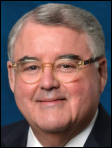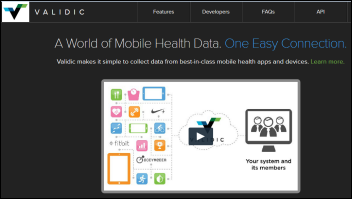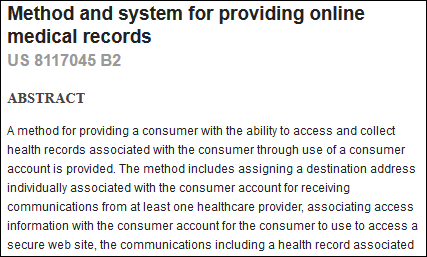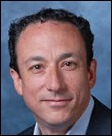Regina Holliday is a Washington, DC-based patient advocate and artist known for painting a series of murals depicting the need for clarity and transparency in medical records. After her husband’s death from kidney cancer in 2009, she painted "73 Cents," a mural showing her husband dying in darkness surrounded by inaccessible technological tools in a closed data loop. The title refers to the cost per page charged to patients to obtain their medical records in the state of Maryland.

Give me some background about what you do and what The Walking Gallery is.
Almost five years ago, my husband had cancer. He was in the hospital for 11 weeks. We had very little access to his electronic medical record. He died in the 12th week. I decided I would do everything in my power — speaking, painting, writing — to try to change healthcare and make it become where the patient’s story is front and center, and within hospitals, you can get to your medical record in real time.
That’s why I paint giant murals and that’s why I started a movement called The Walking Gallery, where people have paintings on the back of their business suit jackets and the goal of the patient’s story is front and center.
You just spoke at the HIMSS conference. Did you leave it feeling that patient engagement and advocacy are really taking hold or is it just a few folks hoping that it is while the rest are indifferent?
I’ve spoken now at several different informatics societies. I’ve been excited to see how much HIMSS is embracing patient advocacy in a real way. It doesn’t seem to be token and it’s growing every year, which is real exciting to see. I’m sure it’s incredibly frightening for them to watch it take off.
HIMSS tries to serve two factions, high-paying vendors who want to sell products and providers who are their prospects and users. But usually absent from those discussion are the patients all of that technology affects.
Before I worked in healthcare, I came from the toy industry. I’m very familiar with Toy Fair, which is gigantic trade show. There’s a lot of similarities, because just like in that world, you’re focused on sales, high-dollar items, and what’s going to move that year. But you’re also really focused on the fact that your customers are children. There’s this wonderful, youthful spontaneity to that product line, the concept of selling toys.
In healthcare, we have somewhat distanced ourselves from the end user, which is patients. I’ve been wanting to see the realization come back that when you’re a vendor, when you’re a provider, whoever you are at HIMSS, inside of you, you are a patient. It’s been really exciting to see people flip and relate to themselves as their patient self before they relate to themselves as their vendor-provider self.
Will patients ever have that kind of power where they’re like a customer in any other industry?
Yes. It’s coming. The beautiful thing that happened to medicine was social media. The ability for patients, regular folks who have no organization behind them, to have an equal voice to a company.
While I was at HIMSS, they had trouble getting my hotel room. I was tweeting about it, and within less than two hours, I was talking to Hilton, the national channel. Later that day, I was talking to Hyatt, the national channel. That kind of power didn’t exist before — the ability as an individual to communicate with large organizations. It’s changing everything.
Do you think that’s really the case? At Hilton or Hyatt, you’re paying the bill, and if you’re unhappy, you stop using them. But in healthcare, you don’t necessarily get to choose where you receive your care or control what you pay for …
I disagree with that. The model of care is rapidly changing. With the Affordable Care Act and a lot of consumers becoming high-deductible plan payers, they’re determining where they’re getting their care. The ability to make choices about where you’re going to get your care affects the bottom line in institutions. With things like HCAHPS scores, patient satisfaction scores, now being publically available, with transparency in pricing becoming more and more demanded, you have an end-user consumer that’s actually becoming very empowered.
What do you see as the impact of the Affordable Care Act?
Major major groundswell change. People becoming very interested in the fact they have choices in policies. 2008 really hurt a lot of this country. People were wedded to a location, a job, and insurance that came with that job. Which meant that, unfortunately, a lot of people who should have been able to move so they could economically better themselves found themselves not in a position to do so.
Affordable Care Act comes on the stage. Now all of a sudden we are getting the ability to untangle our health life from our job life. That allows for a whole bunch of people to work at different organizations, start new businesses, go the freelance, self-employed contractor route when they thought they couldn’t do that before because they couldn’t get insured. That allows us to have a looser economy.
Honestly, when it comes to Americans, we are spectacular at innovation and creativity. Those things are squashed if you’re forced to stay in a job that you don’t want to be in any more. For a long time, the way we set up our insurance in this country, you were forced in that position.
Inpatient demand is dropping, so hospitals are using their money and clout to buy physician practices to shore up their protected markets. Will they be able to end run the trend that would place them less at the center of the healthcare universe?
Not if we do a really good job with transparency exposure in social media. You’re opening people up to what’s really going on and then make different decisions. Also, we need to get in the world view wonderful facilities that are the future of healthcare.
I just toured Eskenazi Health in Indianapolis. It’s a safety net public hospital. It’s astounding. They get it. They get where the future’s heading, which is a health and wellness hub where the community is still going to the hospital, but they’re not going to the hospital for the same reasons they used to go.
Hospitals that get it, that see the future as the way it is coming, are going to succeed. The hospitals who don’t get it, there’s a really good chance they’re going to go down.
It’s rare anything takes root in healthcare unless someone makes money from it. The right thing to do doesn’t always win. Does patient involvement have a strong business case?
Yes. We in the past have not looked at the potential the facility has. We were all about, “Fill the beds, fill the beds.” That’s not necessarily the future way people are going.
Videoconferencing, mobile technologies, people wanting to have a health community. Patient communities are really, really skyrocketing. You have to think in a different way. It’s more of like a library hub direction with wellness activities and physical activities. Why can’t there be sick child care? I was in Lawrence, Kansas back when they were doing that back in the 1990s.
There’s different ways that you can make money that are wonderful, legitimate ways to make money that actually helps citizens, as opposed to the system that we’ve had that were incentives for failure. There were incentives for person getting an infection and staying longer. We have to flip that matrix to where healthiness is the incentive.
Putting patients at the center of healthcare is, unfortunately, a big change. For those overwhelmed by the long-term vision, what would be some short-term goals you would settle for?
I often look at the intersection of health and art. That’s one of my focuses. We need way, way more realistic visuals of care. Less stock photography, more painting. More involving regular people into the life of your hospital.
I would like to see patients — not just a patient advisory council at hospitals, which a lot of them have — on every board and council throughout the entire facility. I’m talking like EMR workflows as well as M&M reports. We need to be part of the conversation. Because what is absolutely beautiful if you do this is that patients can say things that staff can’t. Staff may be thinking it, but politically they’re put in a position where they can’t say it. Their job can be affected. We don’t want to rock the boat.
Patients, not in a bad way, can say the words, since we’re not hired by the institution, that everybody might be thinking but don’t feel the power to say. Once we’ve said it, all of a sudden things break open. Doors break open and pathways change.
One of the major things I would love to see is truly embracing us as part of the team. Not a token. Don’t have us design your lobby again. But really, seriously involve us in decision-making processes and get our feedback. That’s a great short-term goal, very doable by next week.
What do you think would happen if you bought a random patient a HIMSS conference badge and said, “Tell me what you think about what you saw there?”
I think that would rock. We should totally do that next year. Let’s have a scholarship fund. We’ll call it the HIStalk Scholarship Fund. We will just take random people and send them to HIMSS. Let’s do it.
I think they would not only feel uncomfortable there, they might actually be angry to see all the machinations that go on behind the scenes that affects them but doesn’t involve them.
I think you’re right. There’s some people who would be very freaked out. I would recommend a cross section throughout the United States. Since I speak nationally, I do find there’s major regional differences in the way people talk to folks, strangers in crowds and things like that. If we had a good cross section — West Coast, Midwest, South, East — attend HIMSS, that would be spectacular. Since it’s in Chicago this coming year, it can be an entire concept since that’s the middle of the country. I would totally be behind you on that.
Did you see any technology in the exhibit hall that excites you in being able to allow patients to get more involved in their care and see their own information?
This year I felt HIMSS wasn’t showing a lot of new product. I thought HIMSS was truly embracing the stuff they were introducing as new products a few years ago. Now mobile health wasn’t like this weird new thing of will it work, but pretty much an accepted reality, which that was really great to see.

I don’t know if you saw my painting, HIMSS and HERS, that I painted at the event. I was still frustrated by the way larger demographic that is male than female at HIMSS. I even went by a booth where the women were complaining about their heels. I said, “Why don’t you just wear sensible shoes?” They were like, “Well, you know, we have to wear nice clothes because somebody could come to the booth and see us not dressed appropriately.” Whoa, is this the 1950s? Do you really think you have to be a booth babe when you’re just as competent at technology as all these guys that are in the space?
I heard that HIMSS had some resistance to bringing you this year because of cost even though they’ve helped you out in years past.
Well, they invited me to attend. They said they had no funding for travel or lodging.
You’re self-funded, right?
Yes. I don’t have an organization behind me. I started a Gittip fund, a crowdsourcing, sustaining model which is pretty cool. I was very excited. I had never seen that before. To help pay for me being at HIMSS.
Between my babysitting fees and going there, I spent close to a thousand dollars just getting there. As patients, we aren’t being paid back by our business to be there because there isn’t one. It is one of those things that can be a hardship. That’s why I was really excited to see Chicago’s coming up, because at least it’s in the middle of the country and it’s easier to fly there so it’s not so much of a hardship to be part of the experience.
Not that your role wasn’t substantial this year because they at least did put you on the patient engagement stage, but what do you see as your involvement next time?
Hmm. I’d love to be on a main stage. That would totally be great. That hasn’t happened yet. My goal is one day to keynote at HIMSS. I’m sure it will happen. It’s just a matter of time.
How did you feel that the opening keynote, the most important speaking slot at HIMSS, went to an insurance company CEO?
It was sort of an odd choice. I think it might have been partially because of the Affordable Care Act kind of year. They thought that talking to someone from the industry, especially the insurance industry, would make a lot of sense in this timeframe.
I tend not to judge necessarily so much where a person comes from, what business they come from, but whether they are they an amazing speaker. Do they get the space and do they inspire people? I was really excited when Eric Topol’s keynote last year because he gets it. He understands the space. He understands how to inspire.
When people come to a convention or a conference, they’re not just coming there for the most current information and to get the good vendor deals. Those are really important things. But they’re also going there to recharge, to have the energy to go into next year and be better than they were the year before.
At times, it seems that HIMSS has lost sight of this. Why don’t we just stay home? We can get good deals from home. We go to an event to network with people and to recharge our soul. I look forward to embracing that more deeply in the future.
What would you say to healthcare software vendors?
I want you to think of your parent in that bed or your child or your wife or your husband when you’re designing software. I want you to think of them. Because every single thing you do should be to make sure they get the best possible care. God, I hope you get to that point before it happens in your very own life. If I can do anything or say anything to get you to emotionally that point where you’re thinking about them while you’re designing, then I’ve done my job.
An article called you the Rosa Parks of healthcare.
Because I’m a regular person. I was a teacher, a special needs mom, and a wife. I worked in a toy store for 16 years. I was normal. I decided that as a normal, regular person, I’m going to stand up to injustice. That’s what Rosa Parks did. I didn’t come from healthcare, but I will do everything I can to make it better for folks who live within it.
What are your thoughts for the future?
One of my major goals is that when we get to Stage 3 of Meaningful Use, we have real-time access to the medical record – nurses’ notes, progress notes, doctors’ progress notes, all labs, all information. That should be available to the hospitalized patient just as much as the discharged patient because the hospitalized patient is spending the most money and they need that information in the most timely fashion. That’s my overarching goal and everything I do is toward that overarching goal.
Any concluding thoughts?
This has been absolutely delightful. I look forward to us putting together the HIStalk Scholarship Fund for next year.
That would be fun. Unfortunately, it’s become somewhat predictable in how conferences handle patients on the podium. The person tells a moving, compelling story about a something bad that happened to them, everybody in the audience feels embarrassed and gives them a standing ovation, then they just wipe the tear from their eye and go back to what they were doing before that allowed the problem to occur. The emotional tug is there, but nobody can figure out how turn it into something useful.
Years ago, I was a motivational speaker before lunch at a CMIO boot camp. They said, would you like to stay for lunch? I said yes, I’d love to stay for lunch, so I ate lunch with them. Then they said, now we’re going to go into our work sessions and there was that quiet pause moment. I said, can I go to the work session, too? They said, uh, well, yes, it’s going to be very technical, but you’re welcome to come.
I sat in this giant hall with 40 CMIOs. They were talking about a specific vendor system that I had actually seen. I had gone to the company and seen it person. They were talking about problems with files where they didn’t know who the person was, like recognition of the correct patient. I said, I’m confused, you’re using so-and-so’s system and I know they have the ability to have a visual avatar. Every field can have a picture of the patient right there on the field. Why are you having this problem?
They said, no, it doesn’t, it doesn’t have that feature. I said, yes it does. The only way it doesn’t have it at your hospitals is that somebody turned it off. Everyone’s head turned to the front of the room where the man was standing in the front who’d been speaking and was in charge of these all of these facilities. He said, yeah, I just turned it off because I thought nobody would want that.
What was so cool about that moment was that I may have been the motivational speaker of the morning, but I had information to give those individuals that they didn’t have prior to that. That’s the beauty of involving patients. They can often be that little hinge pin that can change things.
Did you ever consider developing a checklist of how to make an EMR more patient friendly?
We’ve talked within the Society for Participatory Medicine about concepts like that. I don’t think there’s a uniform thing yet, but it’s definitely something to put on the list of things we need to do.
There’s things about standardization at work and then there’s some things that don’t work regionally, so you want to have an overarching checklist that you can work with. But the really thing that’s important to remember is every institution works a tiny little bit differently. It’s important to catch their unique differences. That’s one of the things that overarching standards often miss.
What do you think about the Open Notes project?
Love it! I was on Twitter back in 2010 complaining about not having open doctor’s notes when the Robert Wood Johnson foundation tweeted to me. I was like, what are you doing? They said, we’re just holding. We’re doing this amazing study. Watch what we’re doing for the next two years. And I did.
I was so excited at the 2012 press conference when they talked about it. I was there. It was really exciting to paint about it and talk about it. I went to Tom Delbanco and was like, you know, your whole concept made me think of the open note within music, the whole note, the patient is everything, it’s part of the communication with the provider. And Tom Delbanco said you know, it really is that. I’m a musician. The whole concept behind Open Notes was a musical note.
Isn’t that beautiful? It’s one of those things that’s the idea of all of us as provider and patient working together in the totality of ourselves.

































































Anything related to defense will need to go to Genesis.